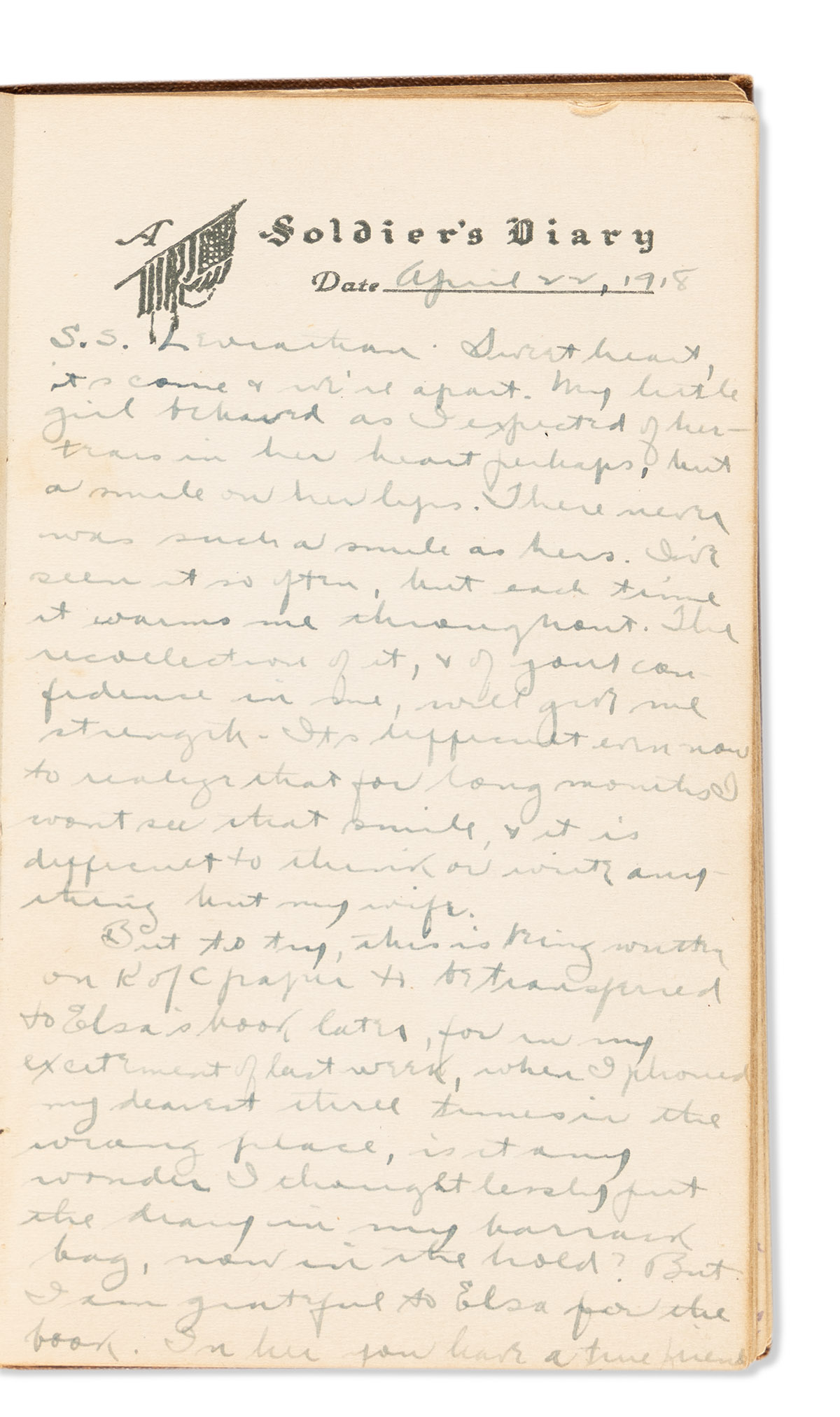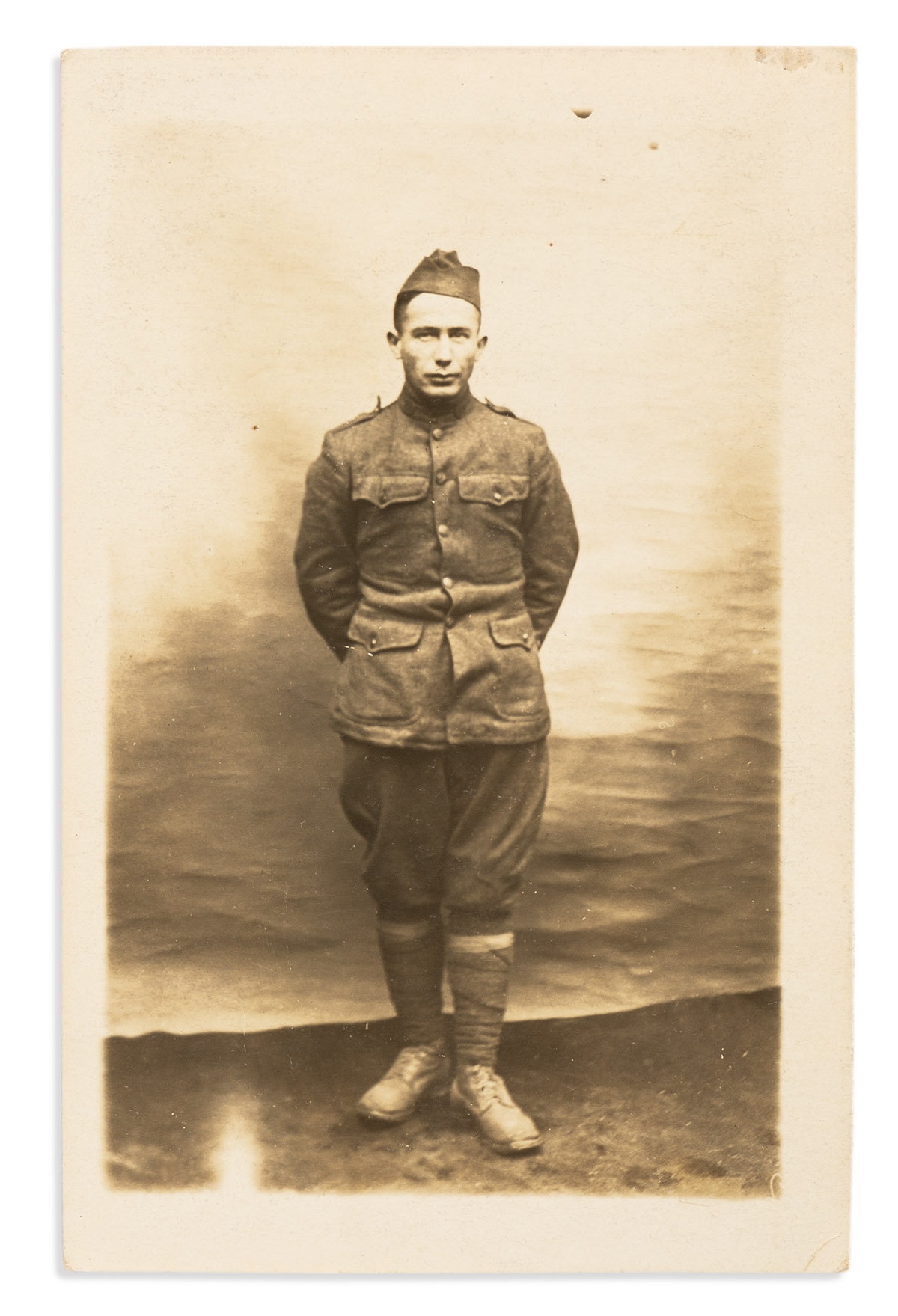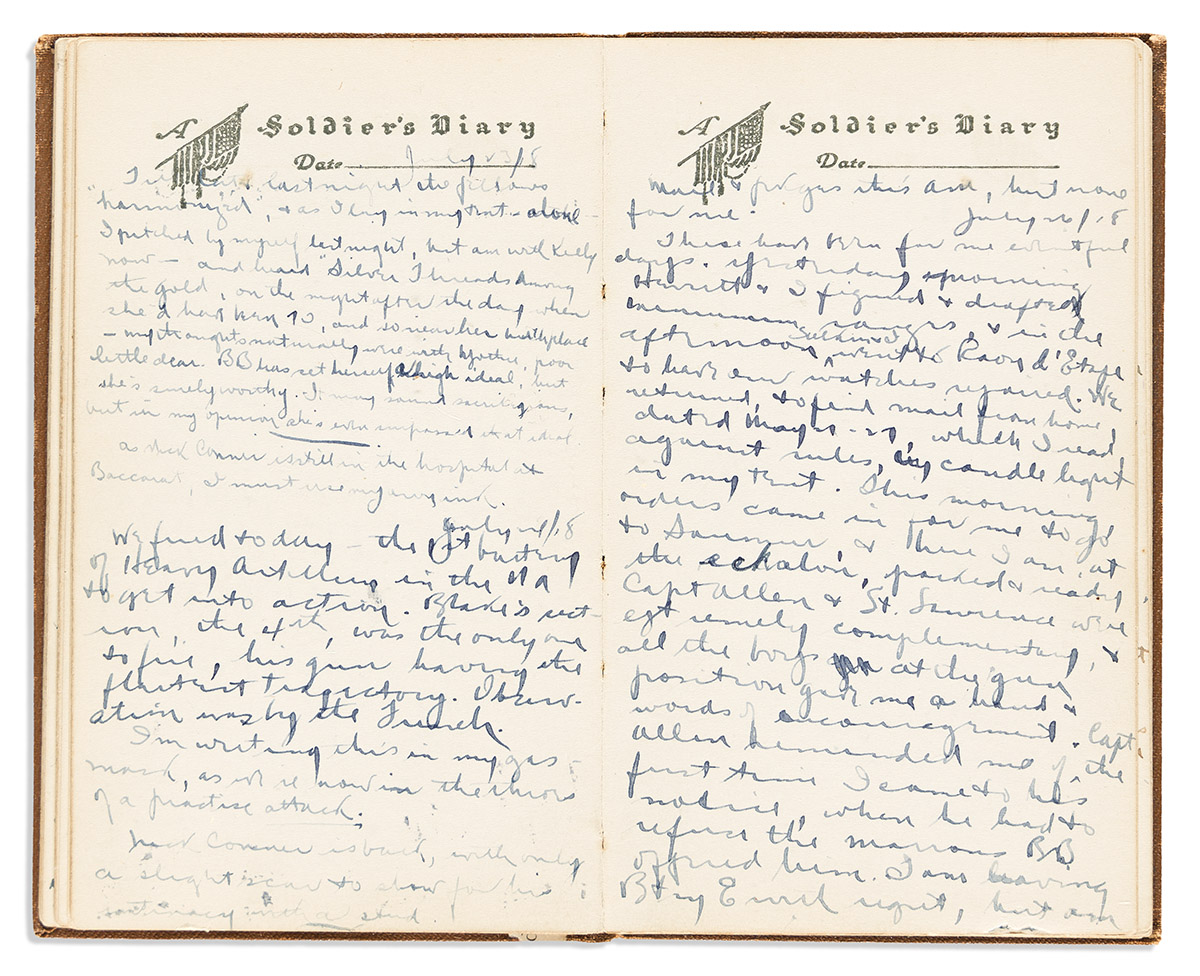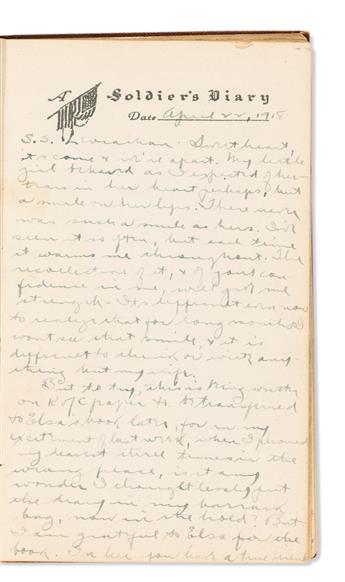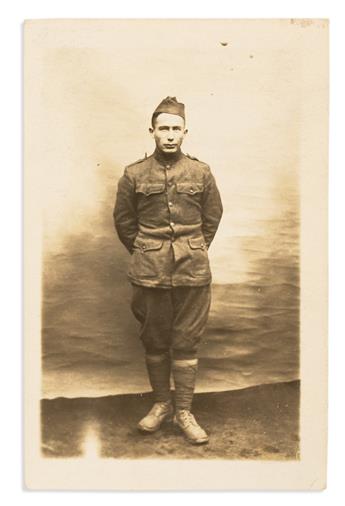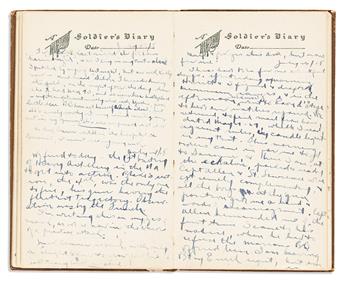Sale 2646 - Lot 299
Price Realized: $ 550
Price Realized: $ 688
?Final Price Realized includes Buyer’s Premium added to Hammer Price
Estimate: $ 1,000 - $ 1,500
(WORLD WAR ONE.) Group of diaries by two members of the A.E.F., and the war letters of a third. More than 100 items (0.4 linear feet) in one box; condition generally strong. Various places, 1917-1919
Additional Details
Well-written diary of a New York artilleryman, Louis Hirsch, who served briefly at the front before attending officer training school. [82] manuscript diary pages plus [8] pages of memoranda. 12mo, original gilt cloth, minor wear. Louis Samuel Hirsch (1892-1976?) of New York City enlisted with the 306th Field Artillery and was appointed Instrument Sergeant. He kept this diary for his wife Bertha Brainin (1894-1960). After training at Long Island's Camp Upton, he lands in France on 2 May. He records an unusual ceremony which took place on 9 June: "The regiment assumed the responsibilities of the upbringing & education of 4-year-old Roger Poget, whose father was a distinguished French officer who was killed in action. The boy was adopted with m[ore] or l[ess] appropriate ceremony. . . . we all filed round, shaking hands with the poor kid, who was half scared to death. . . . It was really touching, tho, and the boy does look like a fine little fellow, who should be a credit to the regiment." 15 July found him with his unit on a hillside near Baccarat with enemy planes flying overhead. The next day he boasted that his Battery E was "the first heavy artillery battery to leave pulled by its own horses, previous batteries were motor transported. It is the first N[ational] A[rmy] battery to go at the front, & will be the first in action" and "the first battery to reach the front without losing a horse." By 20 July, "we've seen air battles, & heard the whistle of shrapnel overhead. . . . Capt. Allen was in the no-man's land yesterday. It's a quiet sector, though the German artillery & machine guns seem strong. However, it's said the German trenches are being kept by an old man & his grandson, the old boy lighting the flares & the kid running around setting off rifles & machine guns." After a week at the front, Hirsch was removed on 26 July to attend the Saumur Artillery School, where he noted on 30 July "Capt. Kermit Roosevelt is also here as a student." On 4 August he added that "one of the funny things that happened is that Charley Taft is Kermit Roosevelt's instructor"--two sons of rival ex-presidents. On 7 October, Hirsch noted that his own third quarter marks paled in comparison: "Capt. Kermit Roosevelt's average is 93%." While in this rather elite environment, he received periodic updates from his unit at the front: "Eleven casualties in Battery E! 50 gassed! Berkemeyer of Battery F--one of the finest fellows who ever lived--is dead. O'Toole is gassed. Our whole machine squad was wiped out" (1 September). Ten days later, "McHugh is dead, Tom Reilly is dead, Whitey Grosz is dead, and Eddie Burns. And lots of injuries & shell shock. I feel very much like a slacker back here, while the boys I was with so long are going through that." On 26 October he passed the exam to become a balloon observer, and then finished first in his section in artillery school, being sworn in as a second lieutenant. He began work as an instructor at the school on 4 November. The next week: "La guerre est fini. Some excitement. Everyone singing, zig-zag, happy." After the war Hirsch resided in Scarsdale, NY. Various places, 22 April to 17 November 1918
Diary of Roland H. Crew. 125 manuscript diary pages, plus [11] pages of memoranda. 12mo, original cloth-backed boards, moderate wear and staining. Roland Homer Crew (1893-1952) enlisted from Philadelphia and was a master engineer in the Army Transportation Service. He arrived in Brest on 17 January 1918, well in advance of most of the American Expeditionary Forces, and helped get the incoming regiments debarked and headed toward the front. On 1 March he was appointed Supervisor of Baggage and Troop Property. The entries in this diary are retrospective and sporadic through 28 July 1918, and then become more regular and extensive. On 1 August 1918, he spotted a famed aviator in port: "Saw Douglass Campbell, the American ace, on the street in front of the Continental. Learned later that he was at dinner at Lebot's with Mac, Hugh, and Tom the night before, having been at Harvard with Hugh." On 8 September he noted "some kind of epidemic, very serious, for past few days among French sailors here feared to be cholera. Talk of quarantining this whole city tonight." On 7 October, a ship arrived with "70 dead on board, and over 400 in hospital. Flu." Various places, 20 November 1917 to 1 February 1919.
War correspondence and papers of William B. Foster. William Barclay Foster (1890-1947) was a lifelong resident of the Pittsburgh area. He was the nephew of the famed songwriter Stephen Collins Foster (1826-1864) and son of Stephen's brother, manager, and biographer Morrison Foster (1823-1904) by Morrison's much younger second wife Rebecca Snowden Foster (1847-1929). William enlisted in May 1917 with Company E of the 15th Engineer Battalion--the first engineering unit to be sent to France. He served overseas from July 1917 to May 1919--much longer than most American soldiers. They helped build railroads, barracks, and hospitals. This lot includes approximately 90 letters written by Foster to his mother while in the service; a photo postcard of Foster in uniform in France, 1918; a folder of approximately 25 war-date letters received, letters concerning Foster, and war-related ephemera, plus a bundle of news clippings. With approximately 30 letters and other items (mostly letters from Foster to his mother) from before and after the war, 1912-1924.
Diary of Roland H. Crew. 125 manuscript diary pages, plus [11] pages of memoranda. 12mo, original cloth-backed boards, moderate wear and staining. Roland Homer Crew (1893-1952) enlisted from Philadelphia and was a master engineer in the Army Transportation Service. He arrived in Brest on 17 January 1918, well in advance of most of the American Expeditionary Forces, and helped get the incoming regiments debarked and headed toward the front. On 1 March he was appointed Supervisor of Baggage and Troop Property. The entries in this diary are retrospective and sporadic through 28 July 1918, and then become more regular and extensive. On 1 August 1918, he spotted a famed aviator in port: "Saw Douglass Campbell, the American ace, on the street in front of the Continental. Learned later that he was at dinner at Lebot's with Mac, Hugh, and Tom the night before, having been at Harvard with Hugh." On 8 September he noted "some kind of epidemic, very serious, for past few days among French sailors here feared to be cholera. Talk of quarantining this whole city tonight." On 7 October, a ship arrived with "70 dead on board, and over 400 in hospital. Flu." Various places, 20 November 1917 to 1 February 1919.
War correspondence and papers of William B. Foster. William Barclay Foster (1890-1947) was a lifelong resident of the Pittsburgh area. He was the nephew of the famed songwriter Stephen Collins Foster (1826-1864) and son of Stephen's brother, manager, and biographer Morrison Foster (1823-1904) by Morrison's much younger second wife Rebecca Snowden Foster (1847-1929). William enlisted in May 1917 with Company E of the 15th Engineer Battalion--the first engineering unit to be sent to France. He served overseas from July 1917 to May 1919--much longer than most American soldiers. They helped build railroads, barracks, and hospitals. This lot includes approximately 90 letters written by Foster to his mother while in the service; a photo postcard of Foster in uniform in France, 1918; a folder of approximately 25 war-date letters received, letters concerning Foster, and war-related ephemera, plus a bundle of news clippings. With approximately 30 letters and other items (mostly letters from Foster to his mother) from before and after the war, 1912-1924.
Exhibition Hours
Exhibition Hours
Aliquam vulputate ornare congue. Vestibulum maximus, libero in placerat faucibus, risus nisl molestie massa, ut maximus metus lectus vel lorem.



